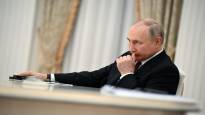The Eurasian Economic Union formed in 2015 is a way for Russia to circumvent the economic sanctions imposed on it by the West.
The Eurasian Economic Forum, which will be held in Moscow on Wednesday and Thursday, is part of Russia’s central project, through which it aims to strengthen its economic power in the regions that were part of the Soviet Union.
President of Russia Vladimir Putin with the start of the war of aggression in Ukraine, friends in the world are running out. This week’s economic forum in Moscow will bring together a large number of these friends.
According to the event’s own website, almost 3,000 representatives from more than fifty different countries are expected to participate in the economic forum. However, the figure has not been confirmed by an unbiased source.
In his speech at the economic forum on Wednesday, Putin blamed the West for the increased energy prices in the world and urged China, India and South American countries to switch to using their own currencies in international trade. One of the main goals of the Eurasian Economic Union is to break away from dollar-based trading.
The Eurasian Economic Union has five official member countries: Russia, Belarus, Kazakhstan, Armenia and Kyrgyzstan. In addition to this, the union has agreed on cooperation with other countries, such as Iran and China.
Although the existence of the economic union has not been officially recognized in Western countries, it is the professor emeritus who has long led the Alexander Institute of the University of Helsinki Markku Kivinen an active and influential organization whose decisions should also be followed in the West.
– The Union’s influence is based on the fact that its member countries and partners have a lot of raw materials and energy resources that other countries do not have. As cooperation between Russia and China has intensified, many projects of China and the Economic Union have been merged.
According to Kivinen, several countries and companies participating in the Eurasian Economic Forum are still outside the sanctions imposed by Western countries. These countries give Russia the opportunity to circumvent various sanctions. By following the Economic Forum, the West can consider whether the sanctions should be extended to other countries trading with Russia.
– Due to the economic sanctions, the export of many Western products to Russia is prohibited. However, it is still possible to export these products through countries cooperating with Russia.
The economic union is the root cause of the entire war in Ukraine
According to Kivinen, the Eurasian Economic Union is the main reason for the outbreak of the war in Ukraine.
In 2013, Russia planned to establish a new economic union as a counterweight to the EU, which would include all the states that were part of the former Soviet Union, with the exception of the Baltic countries. The establishment of the Eurasian Economic Union was a key project for Russia, with the help of which it seeks to strengthen its economic power in the regions that were part of the Soviet Union.
– The accession of Ukraine was decisive for Russia, because the economic union did not include other large economies besides Russia. Russia was also Ukraine’s biggest trading partner at that time, Kivinen says.
According to Kivinen, Russia forced Ukraine to make a choice between the new economic union and the EU, and at least for a while the situation seemed favorable from Russia’s point of view.
Ukraine’s pro-Russian president Viktor Yanukovych decided to reject the EU’s trade and cooperation agreement and was ready to sign an agreement to join the Eurasian Economic Union. The decision was followed by huge protests in Ukraine, culminating in Yanukovych’s removal from office in February 2014.
– The collapse of the plans made Russia resort to different measures in its frontline struggle, and led to the occupation of the Crimean peninsula in 2014, Kivinen states.
Elected to succeed Yanukovych Petro Poroshenko and the country’s new pro-Western government viewed the occupation of Crimea as a declaration of war against Ukraine. The conflict spread to the territory of eastern Ukraine later that year, and in 2022 it led to a full-scale war.
